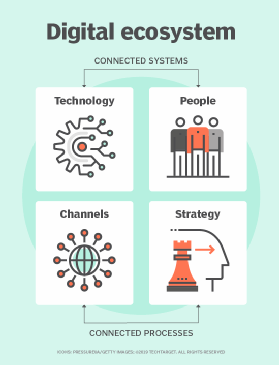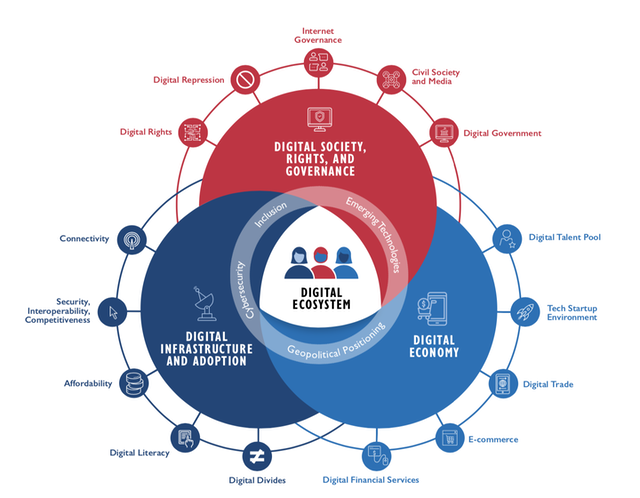Mastering Cross-Platform Integration: Building a Cohesive Digital Ecosystem

Photo from Pexels
Introduction to Cross-Platform Integration
In today’s digital landscape, where customers engage with businesses across multiple touchpoints, the need for a cohesive, integrated digital ecosystem has never been more crucial. Cross-platform integration is seamlessly connecting and synchronizing various digital platforms, applications, and technologies to create a harmonious and efficient user experience. By embracing this strategic approach, organizations can unlock a world of opportunities, from enhanced customer engagement to improved operational efficiency.
The Importance of a Cohesive Digital Ecosystem
A cohesive digital ecosystem is the foundation upon which modern businesses thrive. It allows organizations to provide a consistent, personalized, and streamlined experience for their customers, regardless of the platform or device they use.

Image source: TechTarget
This integration not only improves customer satisfaction but also enables data-driven decision-making, streamlined workflows, and increased operational agility.
Understanding the Different Digital Platforms
The digital landscape is continuously evolving, with a vast array of platforms, applications, and technologies available to businesses. From social media and e-commerce platforms to enterprise resource planning (ERP) systems and customer relationship management (CRM) tools, organizations must navigate this complex ecosystem to create a seamless, integrated experience.

Image source: ProofHub
Understanding the unique capabilities and integration points of these various digital platforms is a crucial step in building a cohesive digital ecosystem.
Benefits of Cross-Platform Integration
The benefits of cross-platform integration are numerous and far-reaching. By bridging the gaps between disparate digital systems, organizations can:
- Enhance Customer Experience: Provide a consistent, personalized, and frictionless experience across all touchpoints, improving customer satisfaction and loyalty.
- Improve Operational Efficiency: Streamline workflows, automate processes, and eliminate data silos, leading to increased productivity and cost savings.
- Leverage Data-Driven Insights: Consolidate and analyze data from multiple sources, enabling informed decision-making and strategic planning.
- Increase Agility and Scalability: Adapt quickly to changing market conditions and customer needs, and scale operations as the business grows.
- Foster Collaboration and Productivity: Enable seamless collaboration between teams, departments, and external partners, fostering innovation and productivity.
Strategies for Building a Cohesive Digital Ecosystem
Developing a cohesive digital ecosystem requires a well-planned and strategic approach. Key strategies include:
- Conducting a Digital Landscape Assessment: Evaluate the current digital landscape, identify pain points, and map out the desired future state.
- Defining Integration Priorities: Prioritise the integration of critical systems and platforms based on their impact on the business and customer experience.
- Selecting Appropriate Integration Technologies: Evaluate and implement the right integration tools and technologies to connect disparate systems and data sources.
- Establishing Governance and Processes: Develop clear policies, procedures, and governance structures to manage the digital ecosystem effectively.
- Fostering a Culture of Collaboration: Encourage cross-functional collaboration and communication to break down silos and promote a shared vision for the digital ecosystem.
Best Practices for Cross-Platform Integration
Successful cross-platform integration requires the adoption of best practices, including:
- Standardise Data and Processes: Establish common data formats, taxonomies, and workflows to ensure seamless data exchange and integration.
- Implement Robust Security and Compliance Measures: Ensure the digital ecosystem adheres to industry regulations and best practices for data privacy and security.
- Continuously Monitor and Optimise: Regularly review the performance and effectiveness of the digital ecosystem, and make adjustments as needed to maintain optimal efficiency.
- Embrace Agile and Iterative Approaches: Adopt an agile mindset, allowing for continuous improvement and adaptation to changing business requirements.
- Invest in Talent and Upskilling: Develop the necessary in-house expertise or partner with specialists to effectively manage and maintain the digital ecosystem.
Tools and Technologies for Managing a Digital Ecosystem
The successful management of a digital ecosystem requires the implementation of a range of tools and technologies, including:
- Integration Platforms: Solutions like enterprise service buses (ESBs), application programming interfaces (APIs), and integration platforms as a service (iPaaS) to connect disparate systems.
- Data Management and Analytics Tools: Tools for data consolidation, cleansing, and analysis to generate actionable insights.
- Collaboration and Productivity Platforms: Solutions that enable seamless communication, file sharing, and project management across teams. Some useful tools for your business are in our last article, read here.

- Automation and Workflow Management: Technologies that streamline and automate repetitive tasks and processes.

- Monitoring and Reporting Tools: Systems that provide real-time visibility into the performance and health of the digital ecosystem.

Case Studies of Successful Cross-Platform Integration
Example 1: Retail Omnichannel IntegrationA leading retail brand implemented a comprehensive cross-platform integration strategy, connecting its e-commerce platform, in-store point-of-sale systems, inventory management, and customer relationship management (CRM) tools. This integration enabled a seamless omnichannel experience, allowing customers to browse, purchase, and return items across multiple touchpoints. The result was a 25% increase in customer satisfaction and a 15% boost in overall sales.
Example 2: Healthcare Data IntegrationA large healthcare network integrated its electronic health record (EHR) system, patient portal, and various medical devices to create a centralized, patient-centric digital ecosystem. This integration allowed for the seamless exchange of patient data, improved care coordination, and enhanced the overall patient experience. The network reported a 20% reduction in medical errors and a 12% increase in patient engagement and satisfaction.
Challenges and Potential Pitfalls of Cross-Platform Integration
While the benefits of cross-platform integration are substantial, organizations may face several challenges and potential pitfalls, including:
- Data Compatibility and Interoperability: Ensuring seamless data exchange and integration between disparate systems and platforms can be a significant hurdle.
- Legacy Systems and Technical Debt: Integrating outdated or legacy systems with modern technologies can be complex and time-consuming.
- Regulatory Compliance and Data Security: Adhering to industry regulations and maintaining robust data security measures is crucial but can add complexity to the integration process.
- Organisational Silos and Change Management: Overcoming departmental and cultural barriers to promote cross-functional collaboration can be a significant challenge.
- Ongoing Maintenance and Scalability: Maintaining the digital ecosystem and scaling it to accommodate business growth requires ongoing investment and expertise.
Conclusion and Key Takeaways
In the digital age, a cohesive, integrated ecosystem is the foundation for business success. By mastering cross-platform integration, organizations can unlock a wealth of opportunities, from enhanced customer experiences to improved operational efficiency and data-driven decision-making.

To build a thriving digital ecosystem, businesses must adopt a strategic, holistic approach that encompasses the right technologies, processes, and organizational culture. By following best practices, leveraging the right tools and solutions, and addressing potential challenges, organizations can create a seamless, adaptable, and future-proof digital environment that drives growth and innovation.
Hire JBM Digital to optimize your business and create a cohesive digital ecosystem that drives growth and innovation. Our team of experts will work with you to assess your current digital landscape, define integration priorities, and implement the right technologies and strategies to build a thriving, future-proof digital environment.
Contact us today!




Recent Comments